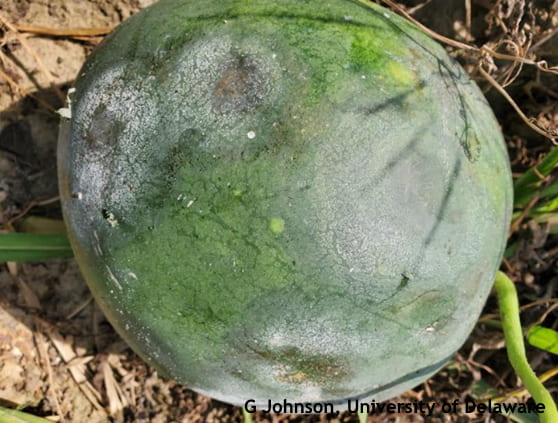Gordon Johnson, Extension Vegetable & Fruit Specialist; gcjohn@udel.edu
As we see wetter weather patterns, Phytophthora blight caused by Phytophthora capsici (P. cap) is becoming a major limiting disease in watermelons. P. cap is not a fungus – it belongs to a group of organisms called Oomycetes which are more closely related to algae than fungi. Oomycete specific fungicides help control this disease in other crops such as pickling cucumbers and lima beans. However, due to the nature of the plasticulture growing systems used in watermelons, with much of a field in impervious plastic, water collecting between the rows allows for the disease to proliferate and spread rapidly when multiple inch rainfalls occur.
Watermelon fruit can become infected at any stage of maturity, either from direct contact with the soil or from splashing rain. Initially, symptoms will appear as small water-soaked areas that quickly enlarge and can become covered in sporangia in high humidity. Sporangia-covered lesions will have a gray to white appearance. The rot will develop rapidly until the fruit is completely collapsed.

P. cap infected watermelon. Note large lesions covered with white sporangia.
P. capsici has two mating types (called A1 and A2) that are genetically distinct. When both mating types are present in one field, they mate to produce survival structures called oospores. Oospores can survive in the soil for many years and provide the initial inoculum for disease initiation when conditions become favorable. The asexual stage of P. capsici, which is responsible for initiating infection, depends on water for infecting and moving between plants. Disease will almost always begin in low spots of fields or in areas that do not drain readily, such as row middles. When contaminated soils are saturated for several hours and temperatures are relatively warm, P. capsici will form structures called sporangia. Sporangia can directly germinate to cause disease; however, they also contain asexual, swimming zoospores that are released into the saturated soil in wet conditions. Zoospores are attracted to living plant parts in the soil and on the soil surface and swim toward them. Once they find a host plant, zoospores can germinate and infect any plant part, but in the case of watermelons, fruits readily become infected.
Oospores are spread from field to field in infested soil adhering to machinery or humans. Zoospores are spread primarily splashing water from rain, or water running through fields during rain events. If contaminated field runoff drains into an irrigation pond, that irrigation pond may become a source of inoculum and spread the pathogen throughout the crop or onto other fields.
As stated before, Oomycete specific chemicals will not fully control P. cap in watermelons. This is because once the fruit sets on the ground, the chemicals cannot reach that part of the fruit. Research has also shown that applications through the drip system are not effective at controlling the fruit rot phase of the disease. Continue foliar applications and start at first fruit set.
On a positive note, resistance to P. cap has been found in watermelon germplasm and breeding lines have been released from the USDA research program in Charleston S.C. (see https://cuccap.org/breeding/watermelon/#phytophthora) However, it will take several years to get this resistance into commercial varieties.
Growers therefore must also use cultural controls to manage this disease. The following are guidelines for cultural control of Phytophthora blight in watermelons:
1) Practice long rotations in fields with a history of P. cap infections. Plant non-host crops such as corn, small grains, soybeans, or brassicas in these fields for at least 3 years (4-5 years would be ideal). Remember that P. cap also infects tomato, pepper, eggplant, cucumbers, squash, pumpkins, melons, lima beans, snap beans and a number of weeds such as purslane, black nightshade, and Carolina geranium.
2) Avoid introducing Phytophthora into uninfected fields. After working in Phytophthora-infested soil, wash soil from equipment. Always work in clean fields before working in infested fields.
3) Water management: Phytophthora requires saturated soils for infection. Use the following methods to encourage drainage and avoid prolonged soil saturation.
- Be careful to not overwater and check irrigation system regularly for leaks and fix them.
- Break up hardpan and encourage drainage by using a V-ripper or other sub-soiling tool in row middles. Do this pre-planting and as needed during the season.
- Avoid soil compaction. Use farm machinery as little as possible throughout the season and never work in fields when the soil is wet.
- Make sure water can flow out of the field. Create breaks in raised beds and clear away soil at the ends of rows to prevent damming.
- Leave windbreak stubble between each row to reduce splash dispersal of inoculum. Inoculum can move rapidly across plastic mulch and bare soil.
- Shape row middles in a V pattern so that water drains to the middle.
4) Limit impervious surfaces (plastic mulch covered area)
- Use narrow width plastic mulch in high, dome-shaped raised beds of at least 9 inches.
- Increase row width. Avoid 6-7’ rows and switch to 8-10’ row widths
5) Consider systems that leave plant residue or cover in the row middles
- Consider mulch based no-till systems for later plantings that do not use plastic mulch
- Use every row rye windbreaks that are planted early to give the most mulch after rolling in the growing season.
- Consider living mulch row middles. We are experimenting with ladino clover row middles that stay throughout the season.
Part of this article was adapted from https://ag.umass.edu/vegetable/fact-sheets/phytophthora-blight
